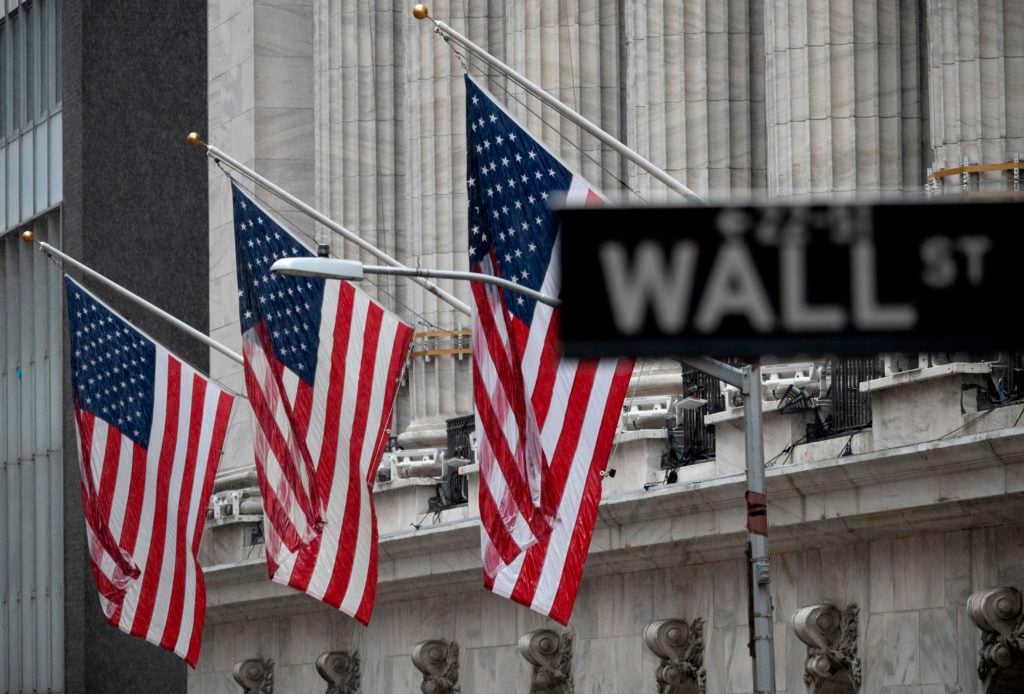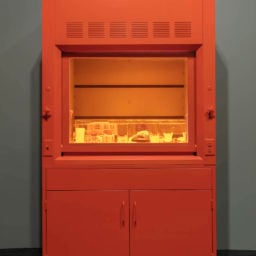Every Monday morning, Artnet News brings you The Gray Market. The column decodes important stories from the previous week—and offers unparalleled insight into the inner workings of the art industry in the process.
This week, using art and business to check in on national mythology…
BILL ME NOW
On Friday, the United States passed a $2 trillion emergency spending bill in an effort to support individual citizens and families, businesses of all types and sizes, state and local governments, and a healthcare sector all facing an unprecedented medical and economic crisis. But in the context of this gargantuan rescue measure, the aid delivered to the cultural sphere and small businesses alike illuminates a larger, more uncomfortable reality about the American Dream.
Known as the CARES Act (you can guess what the “c” stands for, but the rest is Aid, Relief, and Economic Security), the legislation represents the most robust government stimulus in US history, roughly doubling the size of the economic rescue package ratified in response to the 2008 financial crisis. If you’re wondering how much of this cash monsoon specifically irrigated an art system under siege, though, you’re probably going to be disappointed. Even the most generous possible framing of cultural funding in the CARES Act delivers a sum just north of $300 million—and that figure would include a combined $125 million headed to the Corporation for Public Broadcasting and the Institute of Museum and Library Services (the latter to beef up free internet access).
Setting those elements aside, the core of the arts component is a tepid $150 million to be split evenly between the National Endowment for the Arts and the National Endowment for the Humanities. The bill also funnels another $25 million to the Kennedy Center and $7.5 million—cumulatively—to the 19 museums comprising the Smithsonian Institution. For comparison, these line items together total a few million dollars less than the £160 million ($190 million) relief plan passed by Arts Council England earlier the same week. And they are microscopic in comparison to the $4 billion in assistance for US cultural institutions advocated by the American Alliance of Museums, as well as the Metropolitan Museum of Art’s #CongressSaveCulture initiative.
Yet this was still far too much dedicated cultural aid for former UN ambassador and South Carolina governor Nikki Haley, who performatively rage-tweeted that this money could have gone to “people” instead.
Which begs the question: Does Nikki Haley think that institutional collections come alive when the doors are closed and take care of themselves like Night at the Museum? Or that nonprofit staff members and public-broadcasting personalities are unpaid apparitions? In other words, does she believe art and media are literally magic?
The answer, as my colleague Ben Davis deftly unpacked, is “of course not.” He rightly identified Haley’s tweet as the latest example of a longstanding “Pavlovian reflex for conservatives” that aims “to distract from giveaways to corporations and rich people by framing the real problem as lazy cultural elites living off the fat of government subsidies.”
So it is with great pleasure that I break down how the CARES Act actually injects billions more dollars into the cultural sphere than the aforementioned $300 million or so specifically earmarked for nonprofits—but also, distressingly, why the bill proves just how correct Davis is about the political head-fake at work.

Vaughn Spann, Untitled (Flag) (2019). Photo by Matt Kroening. Image courtesy of the artist and Almine Rech, New York.
TO THE RESCUE
Not surprisingly, the CARES Act is a legislative labyrinth. The full text swells to 880 pages. The most sober-minded, comprehensive, and readable analysis of it that I’ve found comes courtesy of Josh Bivens and Heidi Shierholz at the Economic Policy Institute, a nonpartisan think tank that has been advocating for low- and middle-income workers in the US since 1986. And their summary does contain plenty of good news for artists, gallery owners, and cultural workers of all kinds.
I’m going to try to break out that good news into the simplest, most scannable format I can. I’d advise everyone who might qualify for any of the below to check the full details in the final version of the bill, which already underwent some changes from the draft Biven and Shierholz reviewed. (I’ve adjusted where possible.)
1. $360 Billion for Small Businesses
How It Works: This bucket of cash takes the form of low-interest loans, but those loans can be forgiven if employers keep their staff on payroll, and at the same pay levels, throughout the downturn.
Who’s Eligible in the US Art World: Every for-profit and nonprofit business with fewer than 500 employees, theoretically meaning nearly all galleries, self-employed artists, art-services companies, and cultural nonprofits.
Caveats: Applicants must be able to demonstrate they’ve taken a financial loss during the social-distancing era, which may be difficult given the irregular nature of sales and payments in the industry. And while almost all banks and private lenders can provide the loans, they still involve some processing by the US Small Business Administration—a hurdle I’ll come back to in a bit.
2. $300 Billion in Direct Payments to Households
How It Works: The federal government literally is just sending Americans a onetime check or direct deposit for up to $1,200 per person and $500 per child.
Who’s Eligible in the US Art World: Almost everyone!
Caveats: To receive a payment, you must have filed a federal tax return in either 2018 or 2019. Bivens and Shierholz estimate that 30 million Americans have not done that, in many cases because their income was so low that they were not required to. (I suspect more than one artist reading this can relate.) This creates the somewhat ghoulish prospect that many people who are already struggling financially will have to do their taxes in the midst of a historic public-health disaster before they can get this assistance.
3. $250 Billion in Expanded Unemployment Insurance
How It Works: Functionally, it’s the same program of joint federal-state payments made to people who have lost their jobs through no fault of their own, only augmented in a few refreshing ways. Chief among them: Instead of covering only about half of lost wages, the payments will cover nearly 100 percent of the value, and can be received for as long as the next four months.
Who’s Eligible in the US Art World: Anyone laid off since the start of the crisis or furloughed by an employer that was forced to temporarily close (think: galleries, museums, other nonprofits). But for the first time, freelancers and gig workers can also qualify through a special emergency provision, opening up the program to a whole host of ad-hoc art installers, studio assistants, and others.
Additional Details: On top of the usual unemployment-insurance payments (which they have been shut off from in the past), freelancers and gig workers are also eligible for an additional $600 per week. Bivens and Shierholz assert this tweak replaces “essentially” full wage income for the bottom half of the American workforce—and, I’m guessing, an outsize proportion of arts and cultural workers.
Caveats: Not all gig workers may be eligible, and the determining factors are still hazy, according to John Cassidy in the New Yorker. Americans in need also still have to apply with their respective state’s unemployment office (all 50 links accessible here) and meet the accompanying requirements for wages and time on the job, which may not cover everyone.
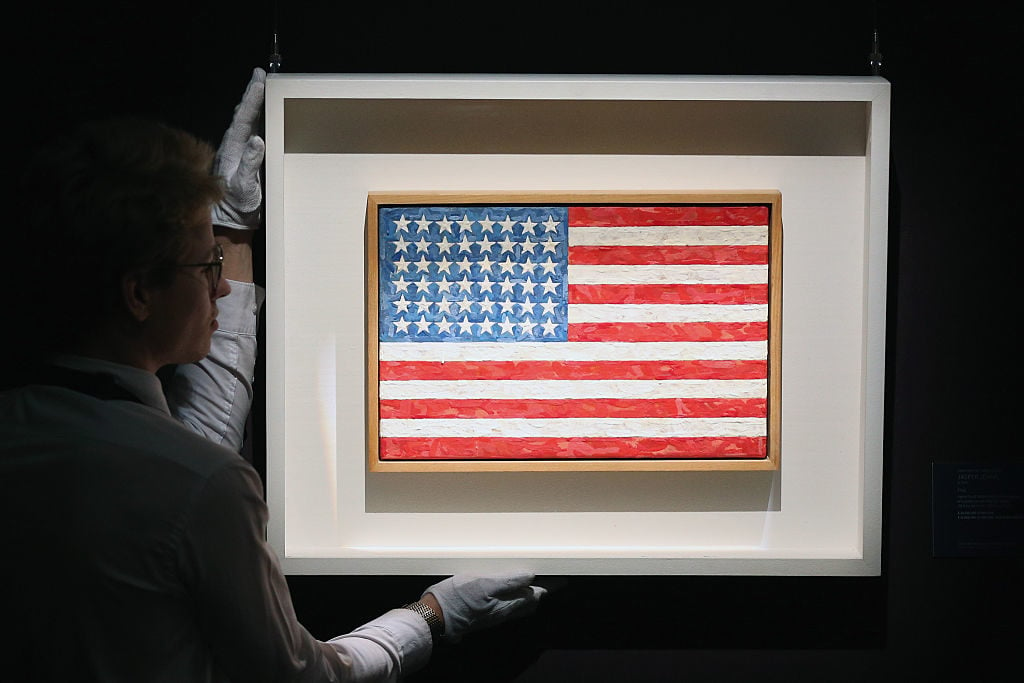
A Sotheby’s employee poses with Jasper Johns’s Flag. Photo by Carl Court/Getty Images.
Now, of course, millions of workers in dozens of other industries will also be receiving some of this money. Still, these three programs give thousands of artists, art workers, and art-business owners a share of around $910 billion in aid. Imagine Nikki Haley’s reaction to that concept, given that the measly $300 million earmarked for arts and media nonprofits made smoke pour out of her ears like a cartoon villain.
This last point clarifies a too-easily-overlooked flaw about the default American attitude toward the art industry: like many other sectors celebrated by politicians of all stripes, it is built on small businesses and entrepreneurship. It’s just that the product—whether it’s an artwork, a museum experience, or a nonprofit program—is niche, and the value doesn’t always translate to spreadsheets. (I will spare you Andy Warhol’s overused mantra conflating good art and good business, because every time an art writer uses it, a butterfly gets sucked into an airplane propeller. To my colleagues in the field: please think of the butterflies.)
But although the CARES Act verifies that art is a fundamentally entrepreneurial sector of the economy, it also clarifies that, even in its most hyper-capitalist, non-art manifestation, the bootstrapping striver is no longer at the center of the American value system—and has not been for some time.
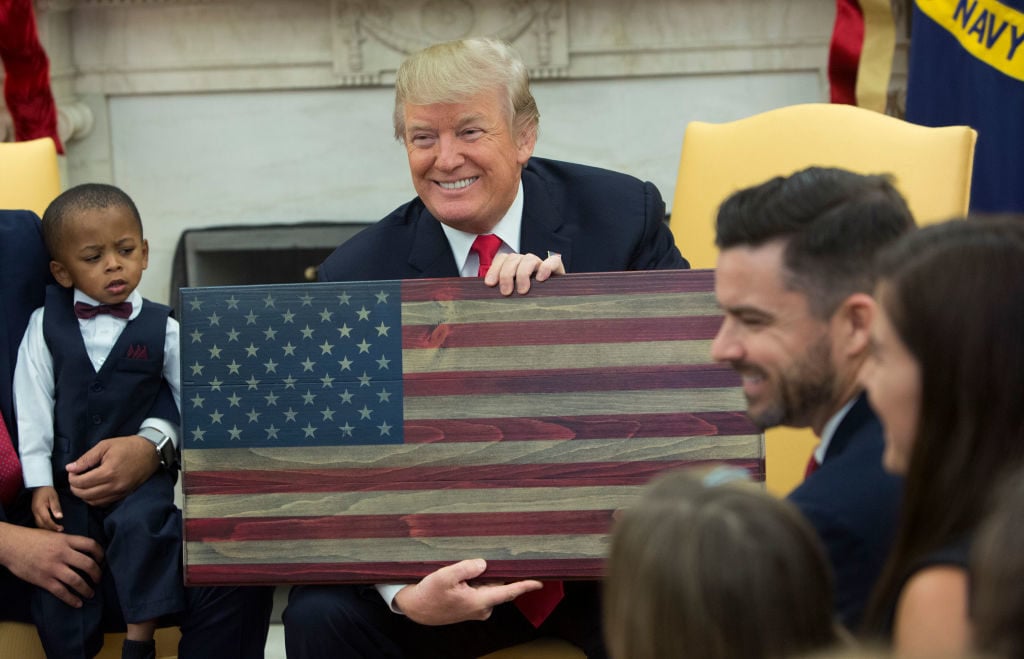
President Donald Trump holds a plaque made by Brian Steorts, the owner of Flags of Valor, on December 5, 2017 in Washington, DC. Photo by Chris Kleponis/Getty Images.
BIGGER IS BETTER, BIGGEST IS BEST
Let’s return to Bivens and Shierholz’s deconstruction of the stimulus bill. While the duo finds minor to modest faults with other bits of the CARES Act, they direct the majority of their venom toward its largest component: $500 billion in corporate bailouts.
Now, the devil’s-advocate argument here is that this discrepancy is only logical. Much bigger companies need much more money for salvation, and since they employ more workers, their rescue should do even more good for Americans than the salvation of small businesses.
While this is true in theory, execution determines whether it’s also true in practice. Bivens and Shierholz think the CARES Act fails miserably on this front:
The single biggest tranche of money in the package is a large pot… aimed at industry rescues, but with no guardrails to ensure that public money is directed toward saving the jobs, wages, and benefits of typical workers rather than the wealth of shareholders, creditors, and corporate executives. The bill calls for industry bailouts to preserve jobs “to the greatest extent practicable,” which is utterly toothless language. Further, there are no explicit protections for worker safety [in the context of current threats to public health].
What’s the big problem? The government regulates the disbursement of the $500 billion in grants to big business by appointing an inspector general and congressional oversight committee—a mechanism Bivens and Shierholz labeled “simply insufficient” even before President Trump suggested that he could legally gag the inspector general from communicating information to Congress at his discretion.
As evidence, Bivens and Shierholz mention that the US took this same approach to policing the now-infamous bank bailouts triggered by the 2008 economic crisis—bailouts that Americans on the political left and right generally agreed were massively more favorable to Wall Street than Main Street.
The potential for corruption here would be troubling news in any country, but it’s even more distressing when contextualized alongside the anyone-can-succeed bedrock of the American Dream. In a study titled “The Missing Millennial Entrepreneurs,” the US Small Business Administration found that the rate of self-employment among people aged 34 and younger “has been gradually declining since 1990.” One think tank used census data to determine that the proportion of new companies to established companies plummeted 44 percent between 1978 and 2012, and the Brookings Institution reported that more American businesses are now being destroyed every year than being founded.
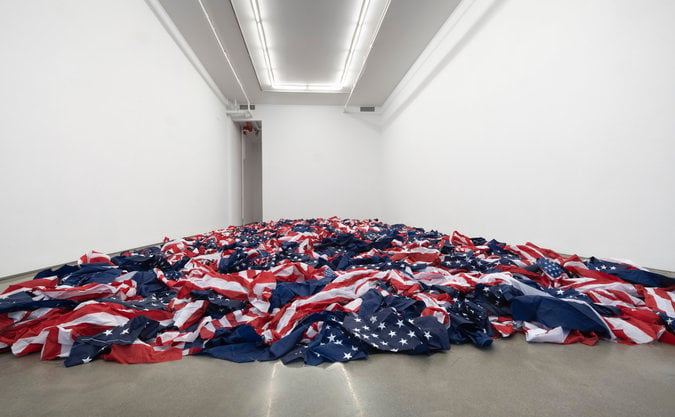
Gardar Eide Einarsson, Flagwaste. Photo courtesy of Team Gallery.
One of the primary reasons for this discouraging trend will be familiar to any observer or participant in an art market dominated by mega-galleries, star artists, and the Big Three auction houses: the consolidation of money and power among the few largest, often oldest competitors in almost any industry. Their still-growing advantages in scale and capital combine with the globalization of taste to form juggernauts that make many young would-be entrepreneurs wonder what the point would be in even trying. And when federal legislators also offer the apex predators bailout deals lacking even modest mechanisms for accountability, as the CARES Act does, the savannah of entrepreneurship becomes even more dangerous for everyone else.
In fact, whether you’re an artist or a startup founder, even the most useful aspects of the CARES Act reveal where the nation’s priorities have shifted. The Small Business Administration has a staff of fewer than 3,300 people who collectively managed to approve only 58,000 loans in 2019. They will now be responsible for guaranteeing $360 billion in loans to a pool of entrepreneurs that surpasses 30 million, only about half of whom have enough cash to weather a full month without customers.
Will the SBA be able to get all that money to so many struggling small businesses before they go under? I’m concerned—especially since its website does not even mention that small-business owners can (and I’d say should) apply for the loans through banks and other private lenders rather than flooding the tiny agency positioned in the legislation as the focal point of this massive entrepreneurial rescue mission.
In the end, the CARES Act serves as a referendum on the American experience in 2020. It once again shows that, in the US, the arts are seen as a public luxury, not a public good; that the art industry is a fundamentally entrepreneurial segment of the economy; and that oligopoly has become an existential threat not just to the art market, but to all markets. And while those realizations corrode the favorable aspects of the bill somewhat, at least we know where we stand.
That’s all for this week. ‘Til next time, remember: no one ever said this was going to be easy.
